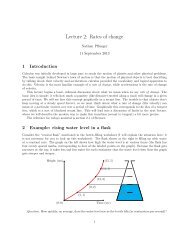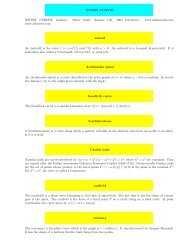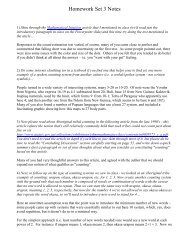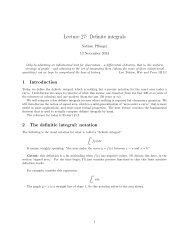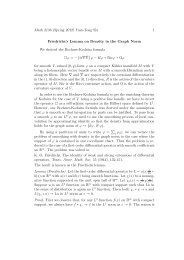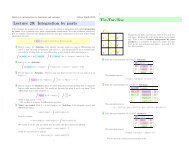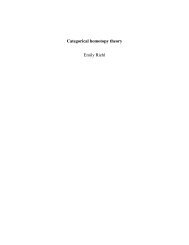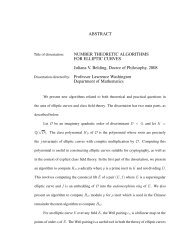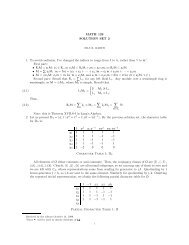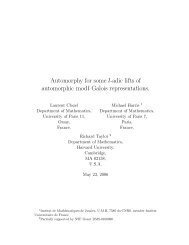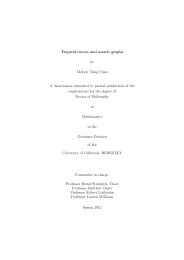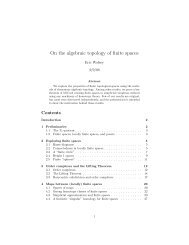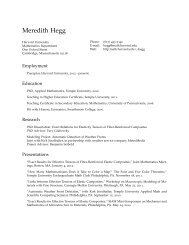Gauge theory for embedded surfaces, II
Gauge theory for embedded surfaces, II
Gauge theory for embedded surfaces, II
You also want an ePaper? Increase the reach of your titles
YUMPU automatically turns print PDFs into web optimized ePapers that Google loves.
<strong>Gauge</strong> <strong>theory</strong> <strong>for</strong> <strong>embedded</strong> <strong>surfaces</strong>, <strong>II</strong> 69<br />
and l ′ = − 1<br />
2 〈[c],Σ〉. The decomposition Ē = εR ⊕ c gives a decomposition of the<br />
connection Aα as Triv⊕Bα. This in turn induces a decomposition of de<strong>for</strong>mation<br />
complex<br />
as the direct sum of<br />
and<br />
0 → L p dAα<br />
−→ L 2,Aα<br />
p<br />
d<br />
1,Aα<br />
+<br />
Aα<br />
−→ L p → 0<br />
0 → L p<br />
2<br />
d<br />
−→ L p<br />
1<br />
d +<br />
−→ L p → 0<br />
0 → W p<br />
2 ( ¯ K) dBα<br />
−→ W p<br />
1 ( ¯ K ) d+<br />
Bα<br />
−→ W p ( ¯ K ) → 0.<br />
(See [KrM], section 3, <strong>for</strong> the notation.) The presence of the holonomy parameter<br />
α makes the selection of precise conventions <strong>for</strong> the orientations a slightly<br />
different process from the usual case. To spell these out, the complex structure<br />
on c is such that the holonomy around positively oriented small circles linking<br />
Σ is exp(−4πiα), and the real summand is identified with R in such a way that<br />
the generator 1 acts with positive weight on c. (Note that Σ should be oriented<br />
at this point.) With these conventions, the first complex in the decomposition<br />
is oriented by the choice of a homology orientation. For the second complex,<br />
we give ¯ K the opposite complex structure to that which it obtains through its<br />
identification with c, and we orient the cohomology using this complex structure.<br />
This determines an orientation of the determinant line which we can propogate<br />
by adding instantons and monopoles.<br />
to any B α k,l<br />
The reason we have chosen to give ¯ K the complex structure of c −1 becomes<br />
clear when, following [D3], we compare the orientation just defined with the<br />
natural complex orientation of the moduli space of parabolic bundles in the case<br />
that (X,Σ)isaKähler pair. For the parabolic bundles, the de<strong>for</strong>mation <strong>theory</strong> is<br />
governed by the ¯ ∂ complex coupled to the sheaf T of (8.22). We can decompose<br />
T as<br />
T = O⊕K −1 ⊕K[−Σ]<br />
where K is the sheaf of sections of c −1 . The index of the ¯ ∂-complex on these<br />
three summands are respectively<br />
− 1<br />
2 (b+ − b 1 +1) on O<br />
− 1<br />
2 (b+ −b 1 +1)− 1<br />
2 K·(K + KX) on K −1<br />
− 1<br />
2 (b+ −b 1 +1)− 1<br />
2 K·(K−KX)+2l−(g−1) on K[−Σ]<br />
These summands have their own complex orientations, but our chosen orientation<br />
differs from this complex orientation on the second summand. As in [D3]<br />
there<strong>for</strong>e, granted the right convention on choosing a homology orientation on a<br />
Kähler surface, the orientation of the moduli space determined by the reducible<br />
connection differs from the complex orientation by the sign<br />
(−1) [K·K+K·KX]/2 .<br />
Note that if we had given ¯ K the complex structure of c, we would also have a<br />
sign (−1) (g−1) in this <strong>for</strong>mula.



